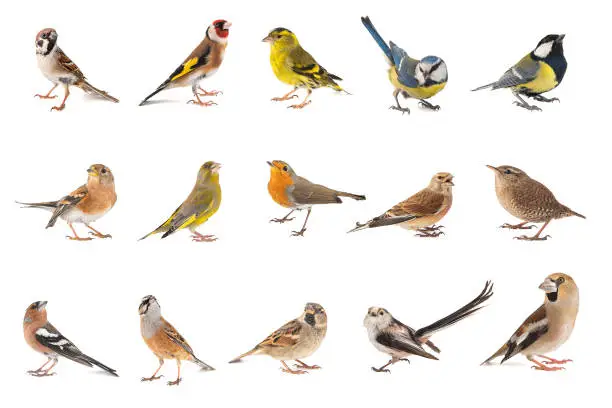Birdwatching is a delightful hobby that connects us with nature and offers a chance to appreciate the beauty of the feathered friends around us. Small birds, in particular, are a joy to observe due to their vibrant colors, charming behaviors, and melodious songs. However, identifying these tiny creatures can be a bit of a challenge, especially for beginners. If you’re new to birdwatching or just looking to sharpen your skills, this guide will help you spot and identify small birds with ease. Let’s dive into the world of little birds and learn some tips that will make you a pro at identifying them in no time!Why Small Birds are FascinatingSmall birds are often overlooked, but they are some of the most fascinating creatures you can encounter. Their petite size, swift movements, and diverse plumages make them stand out in the birding world. From the ever-energetic chickadee to the strikingly colorful goldfinch, these tiny avian wonders bring life to gardens, parks, and woodlands.Birdwatching isn’t just about spotting birds; it’s about connecting with nature, honing your observational skills, and learning more about the ecosystems around you. Plus, there’s something incredibly rewarding about identifying a bird you’ve never seen before. So, let’s get to know these little winged wonders better!Top Tips for Identifying Small BirdsIdentifying small birds can be tricky, but with a few simple tips, you can improve your birdwatching skills significantly. Here are some key factors to keep in mind:1. Pay Attention to Size and ShapeSize and shape are some of the first clues to identifying any bird. Small birds are typically under 8 inches in length, but there’s still a lot of variation within that range. For example, sparrows are generally chunkier, while warblers are slimmer and more elongated.Take note of the bird’s body proportions, tail length, and beak shape. A tiny bird with a stout body and short tail could be a wren, whereas a slender bird with a long tail might be a flycatcher. Understanding these differences will help you narrow down your options.2. Observe Plumage Patterns and ColorsPlumage is the bird’s most distinctive feature. Even among small birds, the range of colors and patterns is astonishing. Some have striking yellows and blues, while others might sport subtle browns and grays. Paying attention to unique markings, such as wing bars, eye stripes, and tail patterns, can make identification easier.For instance, the vibrant red patch on a House Finch’s head sets it apart, while the distinct black cap of the Black-capped Chickadee is unmistakable. When observing plumage, remember that male and female birds can look different, with males often being more colorful.3. Listen to Bird Calls and SongsSmall birds often have distinct songs and calls that can be used for identification. Birdwatchers rely heavily on their ears as much as their eyes to recognize birds. Warblers, sparrows, and finches each have their own unique vocalizations.If you hear a bird before you see it, take a moment to listen carefully. The cheerful “chick-a-dee-dee-dee” of a chickadee or the buzzy “zee-zee-zee” of a Blue-gray Gnatcatcher can be dead giveaways. Apps like Merlin Bird ID and websites like Xeno-canto can help you match the songs to the correct bird.4. Look at the Bird’s BehaviorBird behavior is another important factor in identification. Some birds, like the American Goldfinch, are bouncy fliers, while others, such as the nuthatches, crawl up and down tree trunks in search of food.Notice how the bird moves, feeds, and interacts with its surroundings. A small bird that flits quickly among branches might be a warbler, whereas one that hops on the ground could be a sparrow. By observing these behaviors, you’ll start to recognize patterns unique to each species.5. Consider the HabitatThe habitat where you spot the bird is a big clue to its identity. Different species prefer different environments, so knowing where you are can narrow down the possibilities. For example, woodland areas are home to many warblers and wrens, while open fields might be the playground of sparrows and finches.Keep in mind that some birds are more adaptable than others and may be seen in various habitats. Understanding where to look is half the battle in identifying small birds.Common Small Birds and How to Identify ThemLet’s look at some of the most common small birds you might encounter and tips on how to identify them.1. House Sparrow (Passer domesticus)Appearance: House Sparrows are chunky little birds with a stout beak. Males have a distinctive gray crown, black bib, and chestnut nape, while females are more subdued in browns and grays.Habitat: They are highly adaptable and can be found in urban areas, parks, and gardens.Behavior: Often seen hopping on the ground in search of crumbs or seeds.2. American Goldfinch (Spinus tristis)Appearance: Males are bright yellow with black wings and a black cap in the breeding season. Females are a duller yellow-brown.Habitat: Prefers open fields, meadows, and gardens, especially where thistles and dandelions grow.Behavior: Watch for their undulating flight pattern and listen for their sweet, twittering song.3. Black-capped Chickadee (Poecile atricapillus)Appearance: These birds are small and round with a distinctive black cap and bib, white cheeks, and soft gray bodies.Habitat: Common in woodlands, suburban areas, and parks.Behavior: Known for their curious nature, they often travel in small flocks, flitting through trees and shrubs.4. Ruby-crowned Kinglet (Regulus calendula)Appearance: Tiny and olive-green, the male Ruby-crowned Kinglet has a hidden red crown patch that is usually only visible when excited.Habitat: Found in woodlands, especially during migration seasons.Behavior: Very active, constantly flicking its wings as it moves through branches.5. Carolina Wren (Thryothorus ludovicianus)Appearance: Rusty brown with a white eyebrow stripe, these birds are small but stocky, with a slightly curved beak.Habitat: Common in dense thickets, gardens, and underbrush.Behavior: Known for their loud, melodious song, which is surprisingly powerful for such a small bird.6. Blue-gray Gnatcatcher (Polioptila caerulea)Appearance: Slim with blue-gray plumage, a white eye ring, and a long, black-and-white tail.Habitat: Found in woodlands, especially near water sources.Behavior: Hyperactive, darting between branches and flicking its tail.Tools and Resources for BirdwatchersTo become a better birdwatcher, it’s essential to have the right tools and resources. Here are some essentials to get you started:1. BinocularsInvesting in a good pair of binoculars can make a world of difference. Look for lightweight, easy-to-use options with clear optics.2. Field GuidesField guides are invaluable for identifying birds. Consider books like the “Peterson Field Guide to Birds of North America” or “The Sibley Guide to Birds.” These guides are packed with illustrations, maps, and tips.3. Bird Identification AppsApps like Merlin Bird ID and Audubon Bird Guide are great for on-the-go identification. They use photos, sounds, and location data to help you figure out what you’re seeing and hearing.4. Notebook or JournalKeeping a birdwatching journal is a fun way to track your sightings, note behavior, and record the date and location of each bird you spot.ConclusionBirdwatching is more than just a hobby; it’s a gateway to connecting with nature and discovering the world around you. Small birds, with their vibrant personalities and eye-catching plumage, are some of the most rewarding to observe and identify. By paying attention to their size, shape, colors, songs, and behaviors, you can become adept at recognizing these tiny avian wonders. Whether you’re spotting a chickadee in your backyard or a warbler on a nature walk, every birdwatching experience adds to your appreciation of the natural world. So, grab your binoculars, head outdoors, and let the adventure begin!
 Small Birds
Small Birds 